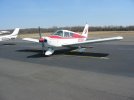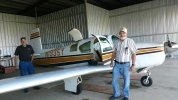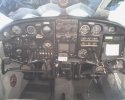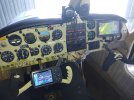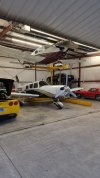I bought my Cherokee 140 in 2004 and completed my flight training in it. My wife and I routinely I used it to visit her parents in MI or in Hilton Head SC where they wintered. From Fredericksburg VA it was 400 NM to either destination and the airport is less than 5 miles from their home. We did other things too but that was the primary mission. After about 2 years I got the itch for a bigger airplane, but I solved it by adding the CAVERNOUS back shelf option to my bird. The shelf added about a foot of floor space behind the rear seat for luggage and turned my bird into a serious XC airplane. We could pile in a week's worth of luggage and have room of our dog too!
The 140 is an honest 100 kt cruiser and could complete 400 NM non-stop without a headwind. It is a little sluggish in warm weather but on cool days it is a little hotrod. Since I routinely fly into a 2100 ft grass strip I trained hard on slow flight and short landings. I also practiced in crosswinds until I could easily land in 20 knots steady wind perpendicular to the runway. I added a Lift Reserve indicator and learned how to use it and trained myself to get maximum performance at the bottom edges of the flight envelope. I learned how to get the shortest and steepest reliable takeoffs and one time on a 45F day I made a short roll maximum lift takeoff and hit 1000 feet altitude before the end of a 3000 ft runway! I could also routinely land and stop with a 500 ft ground roll if it wasn't too warm, and was able to climb with two people at 40 mph indicated airspeed. The LRI and my training regiment had opened up a whole new flight envelope for me to use. Yes the little Cherokee was a pretty good airplane.
Coming into 2017 we had been flying less. My wife's mom had passed a few years earlier and her dad needed help transporting himself between SC & MI twice a year. Initially we flew more as we visited more often, but eventually her dad needed help completing his long trips, so now we weren't flying very much at all. In December 2018 I sold my Cherokee. More to come...
When I sold my Cherokee my broker told me it was the finest example of the type available on the market at that time. I bought it with 0 hrs SMOH and a new interior and recent paint. It looked good inside and out, but it had very few upgrades over the years. When it sold it had 500 Hrs SMOH and 4900 TTAF, the cavernous back shelf, knots-2-U wheel pants, an airgizmos dock with a GPS196, Lift Reserve indicator, really nice interior, and decent looking paint. It still had the original flight instruments, dual radio stack and an ADF.
After the sale I figured I might be done with flying but after about 6 months without an airplane I realized that I needed to own another bird, so I started looking. I was looking for a faster airplane with the same takeoff and landing capabilities. My wife was summering in MI with her dad at their cottage on a small lake, and I needed a faster way to get back and forth so I could run my business and still see my wife regularly.
That led me to look at 200 HP short bodied Mooneys. The first one I looked at had the automatic wing leveler and I didn't like that because it is on all the time. Eventually I got lucky and found an early 1964 Super21 with an electric Nav-o-matic 300 autopilot, all mechanical systems including landing gear, flaps, and a speed brake. Everything was in working order and I loved it. I talked with my AI and had him do a pre-buy inspection, and arranged for training and picked up my new bird in October of 2019. After 20 hours of dual instruction I was flying again.
There are a lot of similarities between the Cherokee 140 and the Super21, and there are some significant differences too. From a numbers perspective the Super21 is great! I can make the trip to MI in 3 hours or less even with a headwind, vs 4 hours or more with the Cherokee. The Mooney burns about 25 gallons LOP, while the Cherokee burned about 33 gallons. The fuel tanks are about the same size, (50 vs 52) which gives the Mooney a lot longer range. The cabin interior volume and baggage area are about the same size but the Mooney is much easier to load with its top mounted baggage door.
It has taken me some time and effort to master the Mooney and I am still trying to get some items nailed down the way I want. I spent an entire summer learning all the principles of LOP operations so I can fly as efficiently as possible without placing excessive stress on the engine and maintain expected engine life. I have upgraded to a CGR-30 combination engine monitor partly because my entire engine instrument cluster failed and I had to do something anyway. I removed the Loran and the ADF and added an AERA760 on the passenger side, and a GPS496 on the yoke, this way my wife can use the AERA760 while I navigate independently the GPS496.
I have spent a lot of time working on my short field landing techniques and I am still unable to duplicate POH numbers as corrected for 85F as published. I should be able to stop with a 700 ft landing roll or less, but so far the best I have done is just under under 1000 ft, with 1200 being a number I can hit regularly. The Mooney wing is not as forgiving at high AOA as the Cherokee so adding a lift indicator did not give me any improved performance at the bottom edges of the flight envelope at all, but it did help me identify some characteristics of the wing. The Mooney wing needs a certain amount of airspeed to get the airflow to attach to the wing, which means that airflow can also rip off of the wing suddenly if pushed too far. This characteristic is more pronounced in ground effect with 2/3 or more flaps deployed, but doesn't present itself during power off stalls in free air. This has led me to have more than a few hard bounce landings.
The Mooney wing does not have as much roll authority as a Hershey Bar Cherokee and crosswind performance is not quite as good. That scared me the first time I ran out of aileron and I am still working on getting more performance out of crosswind landings. I'm sure I'll get better but it will never match the Cherokee for hard rolls and big crosswind performance.
If I could change anything about the Mooney wing I would take a suggestion from Harry Riblett's book and put a slight leading Edge droop on the wing. One of the wings in his catalog of airfoils the same as the Mooney wing. In his work he shows how to adjust he airflow to add a slight droop in the leading Edge nose angle. This is shown to greatly improve the stall angle performance of the wing, giving both a higher stall AOA and a gentler stall across a wider range of pitch movement. This modification will also increase drag slightly with a 1% speed loss at constant power. I think this is acceptable considering how much low speed performance and safety would be gained. I admit that not too many pilots would actively seek this part of the flight envelope, but I definitely would.
The other thing I would change would be the height of the main landing gear. When sitting on the ground the Mooney sits in a nose high attitude, much like a tail dragger but not quite as severe. This means the wing is still trying to fly when all three wheels are on the ground, reducing landing gear applied weight and braking effectiveness, contributing to a longer ground roll. One thing about the Cherokee is the plane sits level or slightly nose down when on all three wheels, ensuring the wing is not flying and allowing maximum braking effectiveness and a shorter ground roll. To change this on the Mooney the rear tires could be made larger, but then they might not fit in the wheel wells and 2 inches of tire only gives 1 inch of lift. Another option would be to lower the gear attachment points, but that might create problems getting the gear to swing up fully and maintain the streamline of the wing.
Incorporating both of these changes may be possible if a new bolt-on wing was designed. This wing would be purpose built to replace the existing wing and include everything good the wing has now and the changes indicated above. It would likely weigh the same as the factory wing, have better stall and braking characteristics, improve low speed performance and margins of safety, and be about 1% slower at the same power settings. I admit that I may be the only person in the world who would take advantage of these changes, so it is likely they will never happen.
Other than those few minor annoyances, I am very pleased with my new bird. I have flown to and from MI and landed on the grass 8 times so far. It is more difficult to land there than it was with the Cherokee, but it is doable. The Mooney is 20% heavier at 2200/2575 vs 1950/2150 for the Cherokee with a 27% increase in useful load of 950 vs 750. It has longer range, burns less fuel, and cruises faster and climbs better. It has a slightly tighter interior but not by much. I'd say my Mooney is a keeper.
So, what is on my realistic list for improvement? I'd like to get my ARC autopilot working again. It was working fine in warm weather, but didn't work when cold. I had the sensor gyro rebuilt to get new grease in there, but it has not worked since that repair was attempted. I might also like to install new front seats with lumbar support. Both of these items are low priority but if something comes up I might spring for them. I might also go for a shoulder harness. One Miracle at a time!




